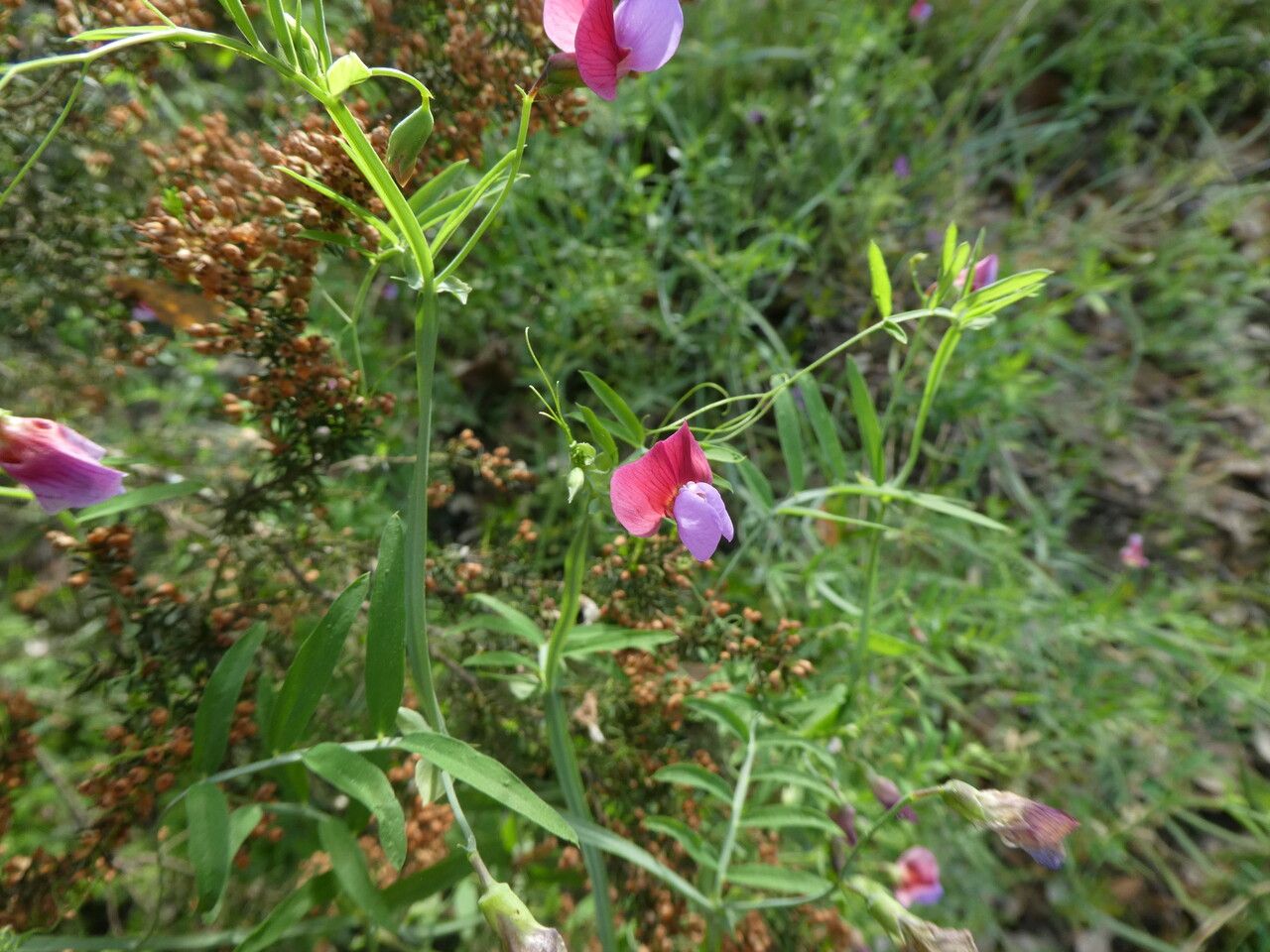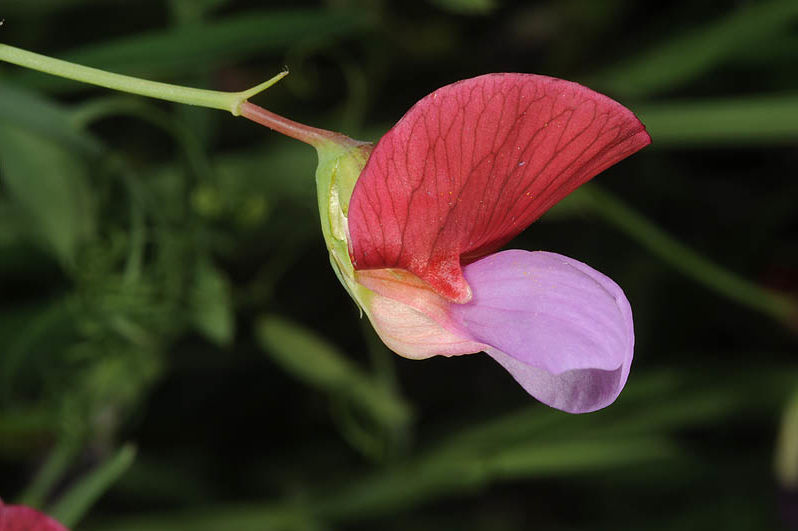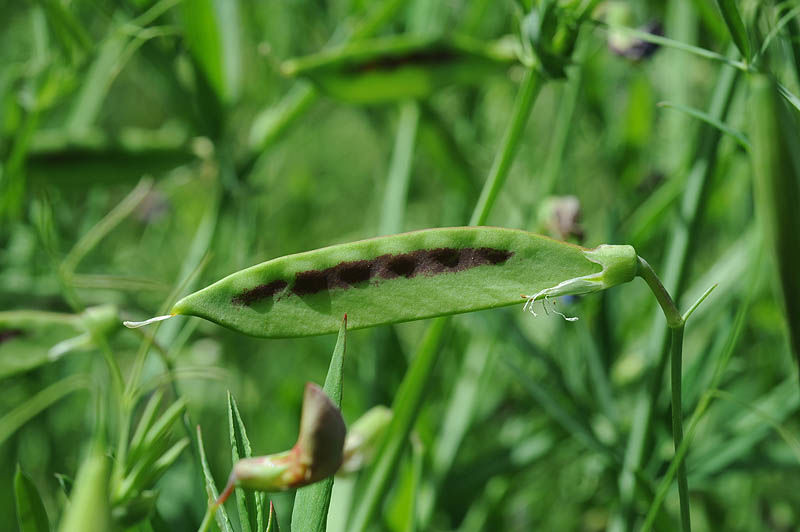Red Sweet Pea
lathyrus clymenum
Also known as: ["Spanish Pea","Red Vetchling"]
Overview
A herbaceous annual legume with vibrant red flowers, native to the Mediterranean region.
Benefits & Perks
["long-flowering","wildlife attractant (bees, butterflies, birds)","drought tolerant"]
Botanical Classification
| Phylum: | Magnoliophyta |
| Class: | Magnoliopsida |
| Order: | Fabales |
| Family: | Fabaceae |
| Genus: | Lathyrus |
| Botanical Name: | Lathyrus clymenum |
Plant Characteristics
Basic Information
- Category: Flowers
- Suitable Location: garden bed or container in a sunny spot
- Suitable For:
- Is Weed: No
- Allergenicity: low
Environmental Needs
- Climate: {"temperatureRange":"5–30°C"}
- Hardiness: {"zones":"6–9"}
- Misting: rarely required, only if ambient humidity is very low
- Drainage: Fast-draining to prevent waterlogging.
- Soil Type: Well-draining loamy soil with added organic matter.
Maintenance Level
- Maintenance Level: moderate
- Toughness Level: moderate
- Pruning Frequency: As needed, typically after flowering or in early spring.
- Pruning Intensity: Light to moderate; avoid heavy pruning unless necessary.
Care Details
Ideal Sunlight Coverage:
Full sun (6–8 hours/day); tolerates partial shade in hot climates.
Sunlight Tolerance Tips:
Acclimate gradually to intense sun; protect from harsh afternoon sun in hot regions; ensure good air circulation indoors.
Care Requirements
Care Difficulty
easyeasy
Sunlight
full sun to partial shade
Rotate plant for even light; use sheer curtains in intense sun; avoid direct indoor light for prolonged periods.
Watering
every 7–10 days during active growth, reduce in winter
Water thoroughly but allow soil to dry between waterings; avoid overhead watering to prevent fungal issues.
Soil
well-drained, loamy soil with moderate organic content
pH: Slightly acidic to neutral (6.0–7.0).
Ensure soil is loose and airy; avoid heavy clay soils; mulch to retain moisture.
Temperature
Prefers 60–75°F (15–24°C); tolerates cooler nights but avoids frost.
Avoid sudden temperature shifts; protect from drafts; maintain consistent warmth during active growth.
Fertilizing
every 4–6 weeks during growing season
Dilute fertilizer to half strength; fertilize after watering; stop in late summer/early fall.
Propagation
Methods
Seed propagation is most common; stem cuttings can also be used.
Step-by-Step Propagation Guide
- Sow seeds 1/2 inch deep.
- Keep moist.
- Or take 4–6 inch cuttings, remove lower leaves, and place in medium.
Best Time: Spring or early summer when the plant is actively growing.
Environment
Warm (65–75°F), humid, and bright indirect light.
Medium
Well-draining seed starting mix or perlite/vermiculite mix for cuttings.
Hormone
Not necessary for seeds; rooting hormone can aid cuttings.
Timeline
Seeds germinate in 1–3 weeks; cuttings root in 2–4 weeks.
Tools Needed
Seed trays, pots, rooting hormone, pruners, misting bottle.
Quick Tips
Use fresh seeds for best germination; bottom heat can speed rooting; maintain consistent moisture.
Pruning & Repotting
Pruning Guide
Method
Pinch back tips to encourage branching; trim spent flowers to promote reblooming.
Pruning Plan
Light pruning to remove dead or weak stems; shape as needed to encourage bushier growth.
Tools
Clean pruners or scissors, gloves.
Checklist
Sterilize tools; prune dead/damaged growth; shape plant; clean up debris.
Repotting Guide
Best Season
Early spring before active growth begins.
Pot Size
Move to a pot 1–2 inches larger in diameter.
Method
Gently remove plant; trim roots if crowded; place in fresh soil with good drainage.
Suggestions
Repot every 2–3 years or when roots fill the container; beneficial for container-grown plants.
Checklist
Choose appropriate pot; prepare new soil; water after repotting; place in appropriate light.
Advanced Care Tips
Watering Mastery
Watering Checklist
Check soil moisture; water deeply; ensure drainage; avoid wet foliage.
How to Apply Water Properly
Water at the base of the plant, ensuring moisture reaches the root zone; water early in the day to minimize evaporation and disease risk.
Watering Schedule Tips
Water deeply once the top inch of soil feels dry; reduce frequency in winter to prevent root rot.
Soil Improvement
Add compost or well-rotted manure; incorporate perlite or sand for drainage.
Temperature Stress Management
Signs of Temperature Issues
Wilting, yellowing leaves, or stunted growth in extreme heat or cold.
Cold Stress
Growth slows or halts; may experience leaf damage or dieback in frost.
Solution: Provide frost protection; move containers indoors; use row covers for garden plants.
Hot Stress
Leaves may scorch, wilt, or drop; flowering may be reduced.
Solution: Provide shade during peak heat; increase watering; use mulch to retain soil moisture.
Fertilizing Guide
Fertilizing Checklist
Use balanced fertilizer; dilute properly; apply during active growth; avoid over-fertilization.
Fertilizing Method
Use balanced liquid fertilizer every 4–6 weeks during growing season; avoid high nitrogen formulations.
Common Problems & Solutions
Toxicity Warning
Cats
Slightly ToxicCats are susceptible to the toxic effects of Lathyrus clymenum seeds if consumed in large quantities, which may result in neurolathyrism. This can lead to severe neurological impairment and motor deficits in felines.
⚠️ Symptoms:
🌿 Toxic Parts:
⚡ Toxic If:
if eaten in large quantities
Dogs
Slightly ToxicThe seeds of Lathyrus clymenum can be toxic to dogs if ingested in large amounts, potentially leading to neurolathyrism. This condition can cause neurological damage and motor dysfunction in canines.
⚠️ Symptoms:
🌿 Toxic Parts:
⚡ Toxic If:
if eaten in large quantities
Humans
Slightly ToxicLathyrus clymenum contains toxic amino acids that can cause neurolathyrism, a condition affecting the nervous system, when consumed in large amounts over a prolonged period. The physiological impact includes damage to the spinal cord and peripheral nerves.
⚠️ Symptoms:
🌿 Toxic Parts:
⚡ Toxic If:
if eaten in large quantities
Frequently Asked Questions
Q: Is Lathyrus clymenum edible?
A: While the plant is not typically consumed, it is related to edible peas, but caution is advised due to potential toxicity.
Q: How often should I water Lathyrus clymenum?
A: Water moderately, allowing the soil to dry slightly between waterings, especially during flowering.
Q: Does Lathyrus clymenum attract pollinators?
A: Yes, its vibrant red flowers are attractive to bees and butterflies, making it a good choice for wildlife gardens.
Quick Reference
| Family: | Fabaceae |
| Care: | easy |
| Light: | full sun to partial shade |
| Water: | every 7–10 days during activ |
Get Expert Care Tips
Download the Plantious app for personalized care reminders and plant identification!
Google Play App Store








